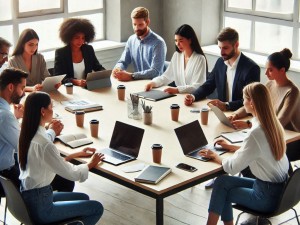As babies engage with their caregivers and interact with their environment, their physical, cognitive, communication and social abilities develop exponentially. At the same time, they need adults to engage with them with attuned interactions and secure relationships. The following article provides information on more on infant and toddler pedagogy so that educators can create rich learning experiences for children in their care.
Infants and Toddlers Thrive In Soothing Environments
When caring for infants and toddlers, ensure that their base environment is calm and unhurried. This involves carefully planning transitions and routines so that they do not feel rushed or your anxiety in “completing” a scheduled task does not rub off on them. Check light, heat, humidity and noise levels so that they are comfortable. Young infants may benefit from safe spaces in which to lie on their backs without fear of toddlers stumbling over them. Plan for ample time to engage babies and toddlers in free play as well as shared play with you, so that you can have high-quality interactions with them.
They Need Continuity In Relationships
Young children, especially babies, can build secure attachments only when they are cared for by familiar faces over time. If possible, put in place a primary caregiving system in which a child is cared for by one person; if not practical, then only by a few carers so that there is continuity in the caregiver-child relationship across room changes, teacher leave days and other service schedules. Having a familiar carer for a baby will offer more opportunities for one person to observe the infant or toddler across a variety of experiences, enabling educators to learn what excites, amuses, upsets and frustrates the child. All these understandings are significant in building future learning experiences for the child’s all-around development.
They Communicate In Varied Ways
A key aspect of infant and toddler pedagogy comprises understanding how they communicate. Babies express basic needs like hunger, warmth, and the need to be cleaned and picked up through crying besides making other sounds like babbling, gurgling and squealing to indicate interest or engagement. Both infants and toddlers use a variety of facial expressions, gestures, postures and whole body movements too such as arching the back or waving their arms and legs about, to convey their wants, feelings and interests. Thus ‘listening’ to children involves not only being attuned to vocal cues and sounds but carefully observing different aspects of children’s body language. Such listening is possible when educators are patient and willing to give infants and toddlers time, space, and support to express themselves; at the same time, educators should be allowed the space to get to know the children in their care and understand their communication cues.
Educators Need To Be ‘Present’
Presence is a key aspect of a caring relationship and involves both physical and emotional availability of carers for children. To ensure this happens, educators should see that children have access and space to be near them or on their lap; physical access can also be expressed through active eye contact and warm welcoming gestures that make infants and toddlers feel safe and nurtured. Emotional presence should be conveyed by paying close and full attention to children in the moment. This attentiveness means that teachers are still and quiet, mindfully present but not actively doing. When carers allow the time and space just for being present, reflecting, and interpreting what children are doing, they foster both children’s learning and well-being in powerful ways.
Interactions Should Be Responsive and Reciprocal
In infant and toddler pedagogy, responsiveness involves being close attuned to their actions and communication cues and reaching out with appropriate actions. Examples could range from an educator responding to a distressed infant by picking them or soothing them to noticing when they start kicking and then placing a mobile or rattle for them to kick. Such responsiveness on the part of the carer not only supports infants and toddlers with emotional regulation but also promotes growing neural pathways necessary for learning. Indeed such responsive interactions build the ground for communication skills. Though babies learn to use sounds and gestures on their own to indicate basic needs, they communicate best when adults cue into their ways of expressing themselves. Through greater eye contact, face-to-face touching, body contact and imitation of their sounds, adults can help babies to communicate better. The repeated object-word association provides the foundation for acquiring language and vocabulary. Above all, the back-and-forth interactions help both the carer and baby to understand each other better, thus further strengthening their mutual bond.
When responsiveness goes a step further and becomes a way of consciously incorporating give and take, it becomes reciprocal. Thus both the carer and child may actively seek out the other’s attention, learn from one another, and adjust in response to the other’s behaviour. One of the most significant types of reciprocal interactions at this stage happens through gaze or mutual eye-to-eye contact which lasts more than a second. Educators should know how to recognise and respond to the ‘look’ initiations of infants with strategies that can be as simple as holding the gaze and smiling broadly to more animated facial responses or affectionate cooing. Another example of reciprocal attention may be looking at the sky when a baby is excited by an aeroplane going by. However developing reciprocity in interactions means that it is important to stop, look and listen for the infant’s or toddler’s response; sometimes when the infant or toddler takes the lead, the carer may take on a more meaningful role just by being observant, reflective and responsive.
Imitative Interactions Help Learning
In order to enhance the learning opportunity of reciprocal interactions, educators can look for ways to imitate the child’s vocal and behavioural cues. Imitation involves a child’s ability to copy others’
- actions with objects, such as banging on a drum or pushing a car
- gestures and body movements like clapping hands or waving
- sounds or words
So if a baby reaches out with a finger to touch your face, use a gentle touch on the baby’s cheek or if they jangle a rattle in a particular way, mirror the action back to them. This back-and-forth imitation is not only hugely enjoyable to the baby but helps them learn to:
- express interest in their caregiver for social reasons - as opposed to expressing basic needs like food or sleep
- Share emotion with their caregiver
- take turns
- pay attention to their caregiver
Intersubjectivity Supports Development
Inter-subjectivity is a special type of interaction that involves two people being attuned to each other’s verbal, emotional and behavioural cues when working together. Infants and toddlers – even as young as eight or nine months - have a strong inclination to engage adults in satisfying communication and shared action and will often initiate these interactions. Such interactions marked by intersubjectivity are deeply enjoyable for babies and toddlers, thereby bringing in a whole suite of benefits from building emotional connections to releasing hormones that support the development of brain cells and neural pathways. Educators can practice it in small ways like reading a book together or rolling a ball back and forth between them. While reading to the baby, an educator can let them gaze at the pictures or even allow them to grab the book and start gumming it. Such actions demonstrate children taking the initiative which should be used to extend the enjoyable experience – like building a conversation about how the book tastes or singing songs related to the topic in the book.
Families Should Be Involved
Building partnerships with families is critical to ensure the best outcomes for babies and toddlers in the care setting - the most immediate reason being that as parents, they know their child best. Families are valuable sources of what their infant or toddler likes, dislikes, is interested or scared of. Additionally, family inputs are what will help carers ensure continuity in routines like naps and feeds besides maintaining uniformity in transition practices like from home to service. Also, children are more likely to accept and build a relationship with a new caregiver when they sense that he or she meets their parents’ approval. Additionally, ensuring positive, open communication with families can help carers be aware of and understand the values, beliefs, expectations and aspirations of families from diverse cultures and backgrounds. Some of the ways carers can build relationships with families are:
- by making them feel comfortable and welcomed in the service setting.
- through consistent and respectful communication through informal chats, face-to-face meetings, phone calls or digital modes.
- by gathering inputs from families across topics such as service programs, preferred communication methods, opportunities for participation and family friendliness of the service environment.
- through continuous professional development which will offer educators the understanding and resources to expand collaborative network with families
The first couple of years of human life is a time of immense growth and development.
Further Reading
Self-Esteem Development From Babies To Preschoolers - The following article provides information on What Is Self Esteem, How Self Esteem Develops, Self Esteem Strategies For Babies, Toddlers and Preschoolers.
Developmental Milestones From 2 Months Old To 5 Years Old - Developmental milestones are a set of functional skills or age-specific tasks that most children can do at a certain age range as they grow and develop. The following provides the developmental milestones from 2 months to 5 years old.
Forming Relationships With Children In Childcare - The following article provides information on Why Relationships Matter, Strategies To Implement When Building Relationships, Stages Of Social Development and more.
Belonging, Being & Becoming Concepts Of The EYLF - Within the Early Years Learning Framework, there are three basic concepts that children’s lives are characterized by. They are Belonging, Being and Becoming.
References:
What Matters In Infant and Toddler Pedagogy, Education Hub NZ
How To Play With Babies, Zero To Three






 As an Educator in Australia, your pay rate falls under the Children’s Services Award 2010. This award states the minimum amount that an employer can
As an Educator in Australia, your pay rate falls under the Children’s Services Award 2010. This award states the minimum amount that an employer can When working as a qualified Early Childhood Teacher (with a university degree) within a service, your rate of pay will come from the Educational Services
When working as a qualified Early Childhood Teacher (with a university degree) within a service, your rate of pay will come from the Educational Services When working as a Diploma Qualified Educator your pay rate is from the Children's Services Award 2010. This Award states your minimum rate of pay
When working as a Diploma Qualified Educator your pay rate is from the Children's Services Award 2010. This Award states your minimum rate of pay When working as a Cert 3 Qualified Educator, your pay rate is from the Children's Services Award 2010. This Award states your minimum rate of
When working as a Cert 3 Qualified Educator, your pay rate is from the Children's Services Award 2010. This Award states your minimum rate of Educational Leaders play a crucial role in their early childhood service by ensuring that the educational program aligns with best practices and supports the holistic
Educational Leaders play a crucial role in their early childhood service by ensuring that the educational program aligns with best practices and supports the holistic In early childhood education and care, ratios are more than a technicality—they are a frontline safeguard. Every child deserves responsive supervision, emotional connection, and developmental
In early childhood education and care, ratios are more than a technicality—they are a frontline safeguard. Every child deserves responsive supervision, emotional connection, and developmental Here’s a comprehensive Mobile Phone and Smart Watch Policy tailored for early childhood education and care (ECEC) services in Australia, aligned with the latest 2025
Here’s a comprehensive Mobile Phone and Smart Watch Policy tailored for early childhood education and care (ECEC) services in Australia, aligned with the latest 2025 With the new national child safety reforms kicking in on 1 September 2025, early childhood services like yours have a real opportunity to lead the
With the new national child safety reforms kicking in on 1 September 2025, early childhood services like yours have a real opportunity to lead the The Sea of Fish Challenge is a national initiative that invites children, educators, families, and communities to create and display fish artworks as a symbol
The Sea of Fish Challenge is a national initiative that invites children, educators, families, and communities to create and display fish artworks as a symbol Across the early childhood education and care sector, educators are sounding the alarm: current staffing ratios are insufficient to deliver safe, meaningful, and developmentally appropriate
Across the early childhood education and care sector, educators are sounding the alarm: current staffing ratios are insufficient to deliver safe, meaningful, and developmentally appropriate


